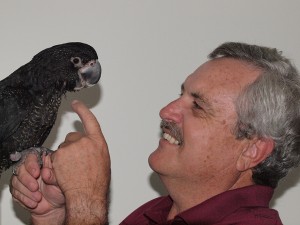Parrot-watching in South-west Victoria
|
|
Birds from the fields nearby also flew in to join the ever increasing flock. Unfortunately, the occasional bird can be hit by a car as it travels in close to the ground. However, we noticed that these cockatoos seemed to be familiar with the speeding cars, and came in relatively high to land safely in the median strip. We noticed larger flocks in the farmer’s fields nearby.
It was a wonderful sight and even though I have seen many thousands of Sulphur-crests, I still enjoy and admire this wonderful, intelligent species. Claus of course had never seen such large numbers, and he was thrilled. As a guide it is a great joy to see people appreciate what you have dedicated your life to - the fascination of wildlife, particularly parrots.
The wonderful grey and pink hues of Galahs against a green backdrop in the late evening sunshine are also a vision to behold. Numerous small flocks of Galahs were also to be seen.
Before long, we had recorded the gorgeous Crimson Rosella and the comical Long-billed Corella. This form of Corella uses his long adapted upper mandible to probe for bulbs and roots in the fields. Large noisy flocks gather and joust with each other to consume the best morsels.
That evening we found a motel in Horsham to overnight. Next morning,bright and early, we set off for what was a first real bird-spotting day.
Going through town to ultimately head north, we came across new species for Claus. I frequently drive with my window down, as I recognize the calls of most of Australia’s parrots. On the main thoroughfare, I could hear the exciting feeding and flock calls of Rainbow and Musk Lorikeets, a few hundred yards away, in a tree- lined suburban Street. I immediately turned around and proceeded up the street and found a flowering gum tree with a large mixed flock of both species.
Claus was surprised at my ability of finding the parrots just by their calls, while driving a car through the early morning traffic. However, hearing is an invaluable tool for bird watchers, and experience in recognizing the calls makes it that much easier to locate a species. Many photographs were taken, but we had to push on to our destination in Wyperfield National Park to see one of his target species, the Major Mitchell or Pink Cockatoo.
Not far out of Horsham we again observed flocks of Long-billed Corella, Short-billed Corella, Galah and the occasional Sulphur-crest. Sulphur-crests prefer wetter areas, and once you run into Mallee country, you notice their absence until you reach areas such as the tree-lined Murray River. The Murray is Australia’s largest river. We saw a small flock of Yellow-tail Black Cockatoos fly across the road, but they continued and never afforded us a great visual as they flew on.
As we drove through the township of Warracknabeal, we noticed parkland around a small river running through the town. Here we spent a pleasant 30 minutes in pursuit of Eastern Rosellas. Many species of wildlife are difficult to photograph because of their shy habits, but where they come into human contact and are unmolested, they can be surprisingly tame.
Being a photographer myself, I can appreciate what needs to be performed to position oneself - or in this case, our hide - which happened to be the hire car for Claus to get suitable images. Red-rump Grass Parrots and Blue-bonnets proved elusive, particularly the latter. Of course we were still recording many other sightings of parrots already encountered, and other birds as well.
We drove on to our overnight destination in the north of Wyperfield National Park. My clients were dumbfounded to find two Major Mitchell Cockatoos feeding on Callitris pine just outside our accommodation. It was still quite hot, and we spent an hour or so chasing Mallee Ringneck Parrots feeding busily on the ground around our accommodation. This species can be difficult to get close to, but due to their interaction with the residents and visitors, a pair was particularly co-operative.
We proceeded to drive around the surrounding grassland and Callitris vegetation, and were lucky to record a single Budgie which no doubt had some other members of his flock nearby. The glorious Mulga, or Many-coloured Parrot, was observed with a pair being hounded by newly fledged young wanting to be fed. By the evening we had now encountered 15 species of parrot in one day. Claus was on his first visit to Australia, dubbed the Land of Parrots, and needed to pinch himself about what he was seeing.
The next morning we did some re-visiting of various locations that had proved fruitful on other trips, but we could not add any new parrots to our tally.
We had a long drive back towards Melbourne, for Claus was leaving the following day back to Denmark. We set off after a late breakfast and had not gone more than a few miles when we recorded Regent Parrots, with their long graceful tails, and the male’s yellow costume was beautifully high-lighted by the sun. They were magnificent and seemed to be prospecting for a nest site. They were far from running water, so I’m sure they would have eventually moved onto a tree-lined water course more towards the Murray River, which is the preferred nesting habitat for this species.
While we were observing the Regents, we noticed Cockatiels which are such a magic small parrot, closely related to the cockatoos. A male showed a lot of interest in a hollow below his lofty position. His interest was due to the fact that his female came to the entrance of her hollow once she had heard us.
We had to make tracks for the wonderful Grampians, so we proceeded without too many stops, retracing our footsteps. Many species were recorded, but no new species were added to our list.
As we ventured close to the western region of the Grampian Mountains, we were fortunate again to see a number of flocks of the Yellow-tailed Black Cockatoo with their mournful cry. Our target species that Claus would dearly love to have seen on this last evening was the Gang Gang Cockatoo. We arrived about 3pm at Halls Gap and proceeded to drive along the surrounding roads. Halls Gap and the Grampians are noted for Gang Gangs and many other forms of wildlife.
Unfortunately, the weather was turning against us, as rain squalls occurred, but we persisted, waiting patiently on foot next to the Fyans River. It was well after 5pm and I heard the unmistakeable feeding calls of Gang Gang. They had arrived on the other side of the river to feed on gum nuts high in the nearby eucalyptus trees. They were too far away for decent images, but with our binoculars, we got great views of a pair.
Both male and female have incredible wispy, filamented, head dresses. The males are red and the females grey. They are a peculiar cockatoo, but magnificent, small and interesting members of the cockatoo family.
We then proceeded along the road towards the caravan park, to photograph the tame Sulphur-crested Cockatoos and Long-billed Corellas there.
As we travelled along in the failing light I once again heard Gang Gangs calling their squeaky, rusty-gate call. We stopped immediately and located the birds above us. To our delight the pair both landed next to the road to waddle down and drink out of the roadside drain. Claus thought Christmas had come early for him!
At the Caravan Park we had Sulphur-crests and Long-bills underneath our feet, and many images were taken by my clients. Christian had asked early in the trip of the likelihood of seeing kangaroos. I obviously replied: not a problem. By the time we had reached the Grampians, he had seen many, however around the tourist town of Halls Gap he just could not believe the concentration of our jolly jumpers.
The following morning we had to look lively, and proceeded directly to Melbourne airport for my Danish clients to catch the plane. Even though we saw numerous birds along the way, we did not have the time to stop. The Danes had seen 18 species of parrot in a little over two days.
I believe Claus now wants to return to Australia to see, among other things, the Palm Cockatoo in the wild.
Peter Odekerken has been keenly interested in wildlife from an early age, and his favourite species include the parrot family as well as finches. He has travelled extensively in the world to satisfy his obsession. Peter has an avicultural interest, but much of his time these days is spent observing species in the wild and taking video as well as still images of birds.
Peter has lectured at many clubs internationally, and spoke at the last Loro Parque Convention in the Canary Islands. To date he has published one book, “A Guide to Lories and Lorikeets”, which is part of the Australian Bird Keeper series”, and he has produced four DVDs, two of which are entitled “Save the World’s Parrots”.
His tours cater for people who are particularly interested in seeing parrots and finches in the wild, but aviaries can be visited as well. They can be arranged in Australia, Africa, Papua New Guinea, New Zealand and the Pacific Islands.
Peter’s concern for the conservation of wildlife is his objective these days and he hopes with his guided tours, videos and images, that people will become aware of how important it is for these species to be found in reasonable numbers in the wild, to sustain themselves for future generations to enjoy.
 For information on Peter’s guided tours, his publications, DVDs and his image library, or to contact him, please visit:
For information on Peter’s guided tours, his publications, DVDs and his image library, or to contact him, please visit:
http://www.parrotimages.com.au/


















